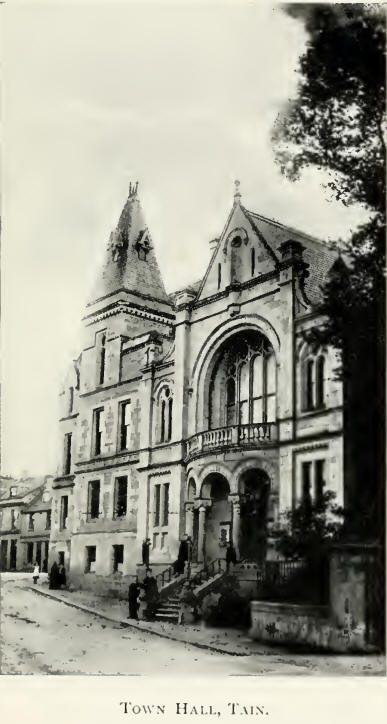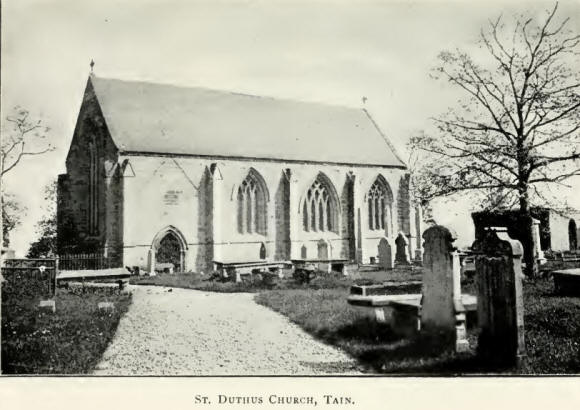|

This ancient Burgh, still
regarded as the capital of Easter Ross is beautiful for situation, placed as
a native poet sings, “Between the heather and the sea,” and well merits its
Gaelic name of Baile Dhuthaich Boidheach (the bonnie town of St. Duthus).
Its situation gives it enviable advantages. Thus, it is built on terraces
which rise up from the sea level and so its drainage is perfect. It is
guarded from the wet west winds by a semi-circle of mountains and thus has a
low rainfall, but yet an abundant supply of excellent water. It is in the
centre of a fertile farming district, while the wooded uplands and the wide
sweeps of the Dornoch and Moray Firths, make the outlook quite picturesque.
From the top of the Clock Tower may be seen the Hill of Tain, Ardlarach,
Struie Hill, glimpses of the Kyle of Sutherland with its enclosing hills,
Skibo Castle (the place Mr Carnegie selected for a residence with the world
before him to choose from), Dornoch with its cathedral, the monument to the
first Duke of Sutherland on the top of Ben Bhraggie with Dunrobin Castle
apparently nestling close to the seaside below, Brora, and the Ord of
Caithness. On the other side may be seen the hills of Banff and Moray, and
nearer, Nigg Hill, where the North Sutor fortifications are; Tarbatness
lighthouse, Portmahomack and Inver, the Fendom and the Morrich, as well as
the whole golf course.
In the town there is much variety in the arrangement of the streets and, as
in all old towns, a few of the streets are narrow and in them the houses are
arranged unconventionally, but many of them have gardens, some of which are
terraced. All houses are nicely built of white sandstone from the hill of
Tain quarry. High Street is the chief business centre, and in an open space
on one side stands a beautiful decorated Gothic monument to the memory of
Kenneth Murray of Geanies. Here are the Court house, Council Chambers, and
the old Tower by the doorway of which stands the old Market Cross. One of
the best known buildings is the Royal Academy, established by charter in
1813, and is the only Secondary School north of Inverness. It is endowed,
ably conducted, and continues to maintain its long established high
reputation as the educational centre of a wide district. There is also a
handsome Town Hall, as well as a Carnegie Free Library.
The town is by no means a manufacturing centre and the existence of so many
shops stored with such a variety of goods is explained by the fact that it
is the shopping centre of several parishes.
There is one building (St. Duthus Church), of which the town is justly
proud. Some of its history has been told in a previous chapter. It was used
for public worship up to 1815, after which it fell into disrepair, but in
1877 it was restored, and an hour or two spent in and around it gives one a
feeling somewhat akin to that which a stranger experiences on his first
visit to Westminster Abbey, and the place may now in a sense be considered
the Valhalla of Easter Ross.
On a bracket in Regent Moray’s pulpit may be seen the old world sandglass by
which in former times the length of the service was regulated. Fixed to the
walls are many memorial tablets to such men as Thomas. Hog, “that great and
almost apostolic servant of Christ,” to whose memory “this tablet is erected
within the walls where in youth he worshipped,” and Patrick Hamilton, the
youthful abbot of Fearn who was burnt at St. Andrews, Dr. Gustavus Aird, Ex-Bailie
Wallace, and Dr. A. Taylor Innes.
The beautiful memorial windows are certainly a striking feature of this
church. One is to the memory of Dr. Angus Macintosh and his son, Dr. Charles
Macintosh, both for many years in succession ministers of Tain. The lower
part of this eastern window is divided by massive stone pillars or sashes
into five parts, and placed in each of these are floral scriptural devices
containing the following texts, “I am the bread of life,” “I am the Rose of
Sharon,” “I am the true vine and the lily of the valley,” “His fruit was
sweet unto my taste.” Each of the divisions is filled with harmonious
colours representing the various flowers, fruit, etc., referred to in the
texts.
The large west window is a four light one and the incident depicted on it is
“John Knox reading the Confession of Faith to the Scottish Parliament of
1560.” The scene is the Parliament Hall, Edinburgh. In the right centre
panel the throne is seen vacant with the crown, sword, and sceptre lying
thereon; a little lower than the throne sits the Regent Moray with an
expression of fixed attention to what is being read. In the left centre
light Knox is represented as reading from a manuscript addressing himself
specially to the Regent. In the right light the Duke of Chatelherault is
seated engaged in conversation with another courtier. Beside him is Nicolas
Ross, Provost of St. Duthus and Abbot of Fearn, dressed in monkish costume
with shaven head and cowl. In his left hand he holds a crosier. In the left
panel Munro, 17th Baron ot Foulis is represented as just after entering the
hall in riding dress. At the back are a number of soldiers, while at the top
of the same panel is seen a gallery, from which a crowd of spectators
eagerly regard the scene below. The minutest details of historical costume,
of oak parquetery flooring, and of the royal chair, have been attended to.
The window on the south wall, next to the east gable, is a three light one.
The historical scene represented is that of King Malcolm Canmore conferring
the Royal charter on Tain. In the centre panel Malcolm and his queen stand
in the foreground, both wearing light coronets, the king bearing in his left
hand a sceptre. In the left panel the Provost of Tain is seen kneeling
bareheaded receiving the charter, while behind him are some of his
companions. In the right light St. Duthus is represented bearing a book in
one hand and a bishop’s staff in the other.

On the centre window in the
south wall the subject represented is Paul preaching before Sergius Paulus.
On the same side and next the south door, there are represented in the three
panels “The angel’s announcement to the shepherds,” “The Nativity,” and “The
Presentation.” A small single panelled window on the north wall next the
east gable illustrates the parable of the talents.
Altogether the church is now one of the most ornate historical buildings in
Scotland.
After all, the people are the most interesting feature of the town. One does
not need to be long in Tain to see that there is no hustle here ; on the
contrary, there is about those who have been resident here for some time
that cultured Oxford lackadaisical air which seems to indicate that life
were not worth living if they were driven from pillar to post. Business with
them is a good thing, but for them life does not consist in unceasing
efforts “to make a pile” for some successor to enjoy. Rather are they like
the Athenians of old intent on hearing some new thing, and so on every
alternate Friday which they call “Corn Market Day,” many of them are with
the numerous visitors from the surrounding country quietly pacing up and
down High Street, at shop counters, or in hotel lounges discussing sometimes
the current price of corn and farm produce and oftimes current politics.
Here again no one seems in a hurry, but socially this foregathering makes
for good fellowship and the cementing of friendships.
The spell which the town and district throws over its sons and daughters is
evident when one gets to know the great number of those who having made a
competency elsewhere return to their native town to spend the evening of
their days in its delightfully calm human atmosphere. For such of those as
can enjoy them, as well as for the youth, there are many societies and
clubs. There are churches of at least four denominations, and for business
purposes there are branches of no fewer than four Scottish Banks, viz
:—British Linen, Commercial, North of Scotland and Town and County, and Bank
of Scotland, as well as an Easter Ross National Security Savings Bank.
There is a Y.M.C.A. and a Y.W.C.A. There are Freemason, Oddfellows, and Good
Templar Lodges, Nursing Associations, Curling, Golf, Bowling, Lawn Tennis,
Football, and Clay Pigeon Shooting Clubs, Territorials and Boy Scouts. All
these in a town of about sixteen hundred of a population means that there
are many people here with time and money to spare. |

